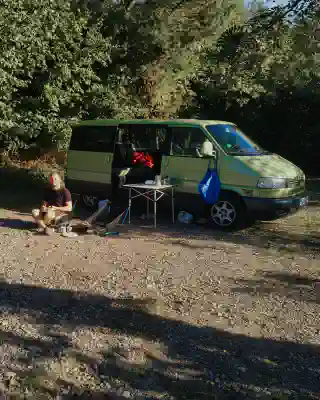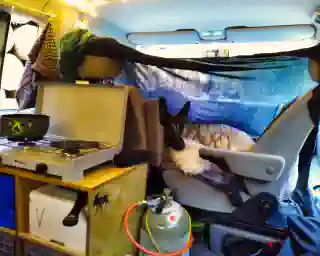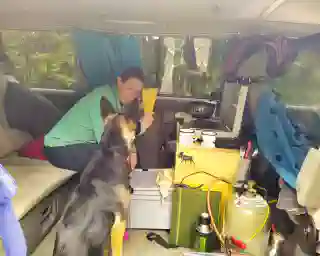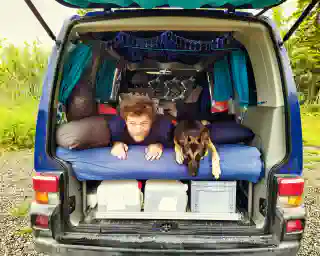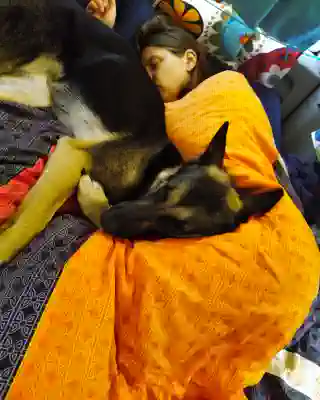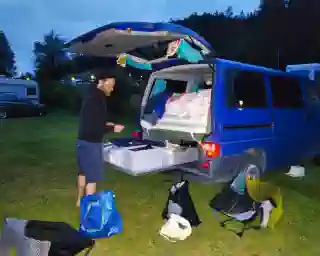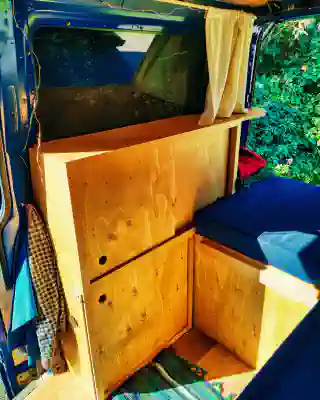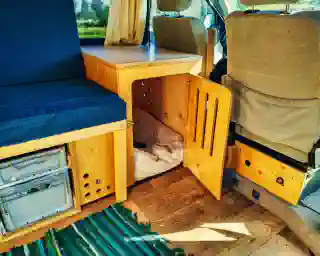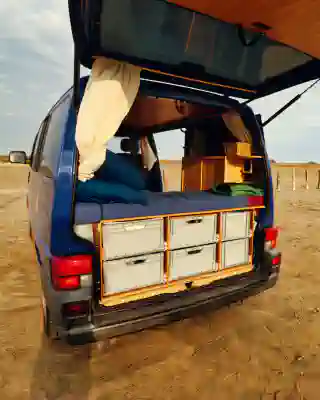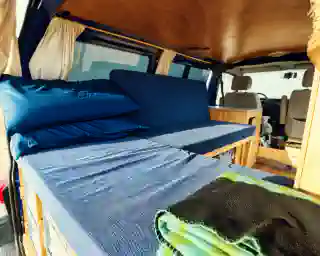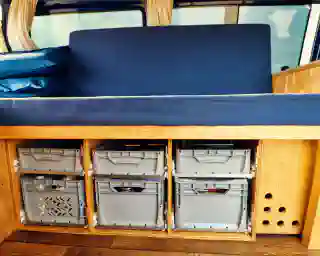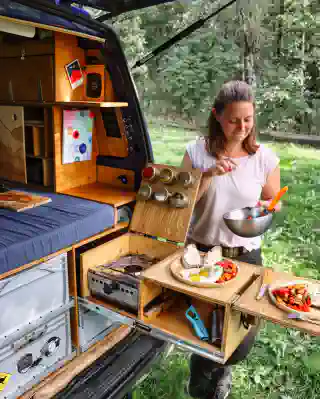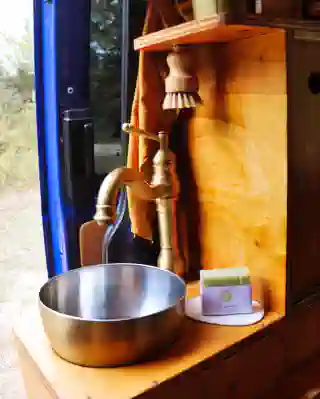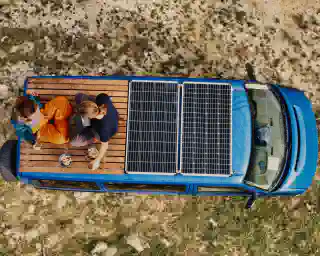
Die Quest - Unser Van, unser zu Hause
Heute möchten wir einige Eckdaten zu unserem treuen Gefährt und unserer zu hause mit euch teilen. Außerdem klären wir, warum wir uns überhaupt für dieses Modell entschieden haben und ob wir es noch einmal genauso machen würden.
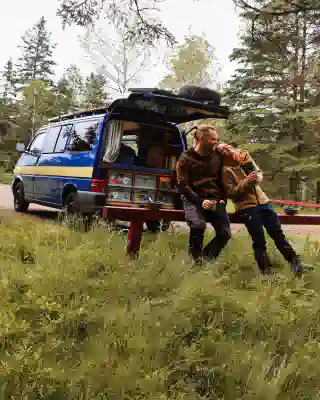
Steckbrief
- Name: Quest
- Fabrikat: Volkswagen
- Modell: T4 Multivan
- Zusatz: Kurzer Radstand
- Baujahr: 1999
Warum ein VW T4 Multivan?
Im September 2020 probierten wir das Vanlife einmal aus. Unsere ursprünglich geplante Weltreise, die wir zu diesem Zeitpunkt antreten wollten, konnte nicht stattfinden – zumindest nicht so, wie wir es geplant hatten. Stattdessen verbrachten wir drei Wochen in Deutschland und mieteten uns einen VW T4 Multivan. Mit diesem fuhren wir in den Schwarzwald und erkundeten Deutschland. Es war einer der schönsten Urlaube, die wir je hatten.
Dieser Urlaub war nicht nur eine lange benötigte Erholungsphase, sondern auch eine Erkenntnis. Wir merkten, dass es für uns möglich und vorstellbar ist, auf so wenig Raum klarzukommen. Mehr noch, die kleine Größe hat definiv auch vorteile. Auf Parkplätzen sind wir nicht größer als ein normales Auto und durch die niedrige Höhe (unter 2 Meter) passten wir sogar in fast alle Tiefgaragen. Außerdem beeindruckte uns die Robustheit des VW T4. Der gemietete Van hatte bereits über 500.000 Kilometer zurückgelegt und schnurrte immer noch wie ein Kätzchen. Nach diesem Urlaub führte Georg umfangreiche Recherchen zu Motoren, Laufzeiten und “Krankheiten” durch. Das Fazit: Es sollte genau dieses Modell sein.
Wir durchforsteten das Internet nach Angeboten und wurden schließlich fündig – unsere Quest.
Ausstattung
Unsere Quest mit ihrem kurzen Radstand mag nicht zu den “großen Nummern” gehören, aber sie reicht aus. Tatsächlich ist mehr möglich, als man auf den ersten Blick denkt, wie wir zu einem späteren Zeitpunkt feststellen würden.
Der T4 Multivan verfügt bereits praktischerweise über ein integriertes Bett. Da wir den Van nicht vorher umbauen wollten, um Zeit und Geld zu sparen, war dies äußerst praktisch. Die Rückbank des Multivans wird nach vorne in den Innenraum gezogen und verwandelt sich in ein großes Bett. Für zusätzlichen Schlafkomfort haben wir außerdem eine Matratzenauflage gekauft.
Abgesehen davon bietet die Quest nicht viel. Kein Kühlschrank, keine Klimaanlage, und kein Schnickschnack. Das bedeutet aber auch das es nicht viel gibt was Kaputt gehen kann und das was kaputt geht kann man ziemlich gut selbst reparieren.
Warum wir nicht vorab ausgebaut haben
Die Antwort auf diese Frage ist einfach: Wie lange plant ihr zu reisen?
Unsere Reise begann mit einem siebenmonatigen Sabbatical. Da wir beide Vollzeit arbeiteten, hatten wir kaum Zeit, den Van vorher umfassend auszubauen. Aber noch wichtiger war die Kosten-Nutzen-Abwägung. Das Geld, das in den Ausbau geflossen wäre, hätten uns während der Reise gefehlt. Also haben wir die Quest flott gemacht und sind ohne aufwändigen Ausbau einfach losgefahren.
Ein bisschen Ausbau…
Drehsitz
Eines der Dinge, die wir bis heute nicht bereut haben, ist der Drehsitz. Er vergrößert den ohnehin begrenzten Innenraum. Außerdem konnte Momo, unser Hund, die ersten drei Monate auf den Vordersitzen schlafen. Das war nur möglich, weil wir den Beifahrersitz drehen und an den Fahrersitz heranschieben konnten.
Schwerlastauszug
Ein bisschen Ausbau war dann doch erforderlich. Wasserkanister, Werkzeugkiste und natürlich unsere Kleidung benötigten Stauraum. Dafür haben wir einen Auszug im Heck der Quest eingebaut. Schwerlastauszüge sind zwar teuer, aber im Verlauf unserer Reise haben wir gelernt, dass sie nicht immer notwendig und praktisch sind. Jedes Mal, wenn wir an unsere Unterwäsche wollten, mussten wir den gesamten Auszug herausziehen.
Küche
Es ist fast lächerlich, das eine Küche zu nennen – eher ein Regal. Hinter dem Fahrersitz, zwischen dem ausgeklappten Bett, fand dieses Möbelstück seinen Platz. Hier stand unser Kocher, und in den vier Fächern bewahrten wir Lebensmittel und Geschirr auf.
Der Vanausbau
Der große Ausbau
Nachdem wir festgestellt hatten, dass sieben Monate nicht ausreichen würden, begannen wir mit der Planung des Ausbaus. Als erstes haben wir aufgeschrieben, was unbedingt in den Van muss. Auf 4 Quadratmetern hat man zwar nicht viel Platz, aber einiges kann auch entfallen. Wir verzichteten auf einen Kühlschrank, weil wir gemerkt haben wie unkompliziert ein Leben ohne einen ist. Ein wichtiger Teil des Ausbaus bestand darin, jeden Millimeter bestmöglich zu nutzen. Wir haben fünf Wochen für den Ausbau gebraucht, und im Grunde ist die Quest bis heute fast unverändert.
Der kleine Ausbau
Der kleine Ausbau dauerte drei Monate, also deutlich länger als der große Ausbau. Das lag daran, dass wir parallel viele andere Dinge zu erledigen hatten und es schwieriger ist, bereits Bestehendes nachträglich zu integrieren. Hauptsächlich haben wir beim zweiten Ausbau unser Dach (Dachterrasse und ein zusätzliches Solarpaneel), das Wassersetup (Einbau eines Unterflurtanks in die Radmulde des Reserverads) und einen größeren Seitenschrank hinzugefügt. Außerdem erweiterten wir das Heck um eine Küchenbox, und im Innenraum fand Nellys Box ihren Platz.
Sind wir jetzt fertig?
Die Frage ist, ob man jemals wirklich fertig wird. Immer wieder haben wir neue Ideen, wie wir den Raum noch besser nutzen könnten oder ob wir hier und da platzsparendere Lösungen finden können.
Aber im Großen und Ganzen ist unsere Quest genau so, wie wir sie haben wollen. Wir verfügen über ausreichend Stauraum, unsere Hunde haben ihre festen Plätze, und vor allem müssen wir nicht ständig hin und her räumen.
Zwar haben auch wir unsere Zeiten wo wir dann denken: Ein größerer Van wäre ja auch nett ABER:
Ein größerer Van würde auch mehr Sprit verbrauchen und gerade der ist in den letzten Jahren sehr teuer geworden und wird auch sicherlich noch teurer werden. Daher sind wir froh, dass unsere Quest nur 7l auf 100km verbraucht.
Ein weiterer Punkt ist, wie oben schon beschrieben, dass ein kleiner Van durchaus praktisch sein kann. In Europa ist das reisen mit einem kleinen Van deutlich angenehmer, man kann jede Straße befahren, kommt in die meisten Parkhäuser und Fähren und Maut sind günstiger.
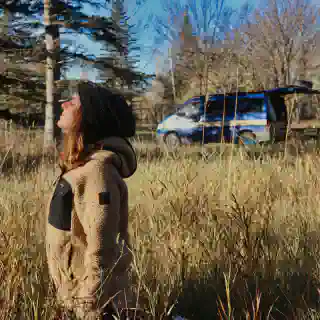
Wir lieben unsere kleine Quest und würden alles in allem alles wieder genau so machen wie wir es gemacht haben.
